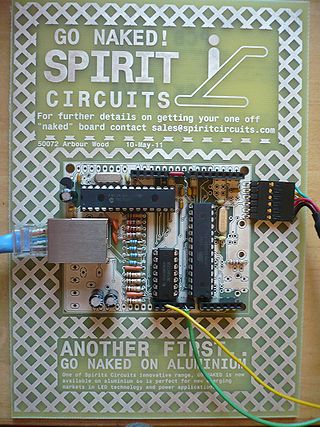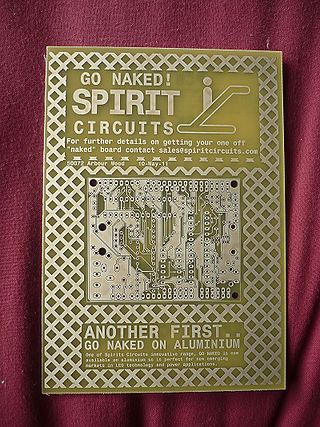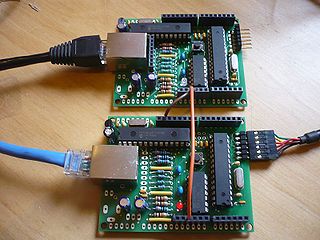Project:Nanode/News
Midsummer Nanodes
The next batch of 100 Nanode kits will be available from about June 21st.
Price is still £18 for Hackspace Members, £20 for non-members. Postage is £2 for UK or EU Airmail.
Payment from now will only be accepted via PayPal (or cash) to ken dot boak at gmail dot com.
If you use the "gift" option - Paypal will not make any deductions.
For more information either contact Ken at the email address above or @monsonite on Twitter
Update - June 6th
Following the most successful Nanode Weekend - here are some latest developments:
Over the two days we had approximately 30 people take part and we built up approximately 30 Nanode kits.
Even though there were some initial nerves about soldering such a kit, every member succeeded to a high standard, and none of the Nanodes produced, failed to perform because of poor assembly. This was a crash course in neat-soldering and everyone who took part deserves a medal for merit.
The biggest difficulty was on Saturday because some of the kits contained the wrong 10ohm and 1 ohm resistors. In poor light it was almost impossible to tell the difference between the silver and gold final bands. In later kits the 1 ohm is marked with a black pen stripe horizontally through its bandolier strip.
Popularity
The initial pledge was more than 25% oversubscribed.
Some weeks ago, in early April we though we might sell 25 Nanodes, then possibly 40 or 50 as the pledge gathered momentum. We took a risk and settled on 100. Then in a rash move Ken decided that 125 might be a better number. We ended up with 145 pcbs as a contingency plan.
Second Wave - Nanode booking List
We have sold all of the batch of 125 and have just ordered another 80 more.
In order that Hackspace members don't miss out on the initial offering, a further 30 units will be available to LHS members and friends under the original terms of £18 per kit. Please contact @monsonite on Twitter for an update to availability.
Put your name here to secure one or more of the next batch of Nanodes - scheduled for the end of June.
Debbie Does Dallas - but Nanode Does OggCamp and Brighton Mini Maker Faire
Catch us at all of the above events - except perhaps for Dallas.
OggCamp August 13th/14th Farnborough Maltings
Brighton MMF 3rd September
Nanode Goes Wireless
A couple of Nanodes have been fitted with wireless modules and are undergoing alien autopsy experimentation deep in the bowels of the Mother Ship. In other words Ken and Nick are dicking around with 433 MHz wireless on the Nanode using the JeeLabs breakout board.
June 4th Update - First Day of Nanode Weekend
A resounding success! 15 people attended and 22 Nanodes built up, tested and working.
To be repeated again on Sunday 5th.
June 1st Update - the pcbs have arrived!
Right on time a whole bunch of Nanode pcbs arrived.
The first one has been built up, tested and is now running code - see photo.
Now have to build a few samples up in time for this weekend's Nanode Workshop.
Update 27-5-2011 Nanode 5 - DHCP Code Ready
Andrew Lindsay and I met up at the Hackspace on Friday afternoon, where Andrew demonstrated his DHCP connection process.
The Nanode was plugged into a spare router socket, and within a few seconds had done a DHCP request and been allocated an IP address. The Nanode then connected into Pachube where it subscribed to a data feed which was used to control an RGB LED. This connection process was fully automatic and proceeded without intervention.
25-5-2011 @Andrewdlindsay has just tweeted me to say that his code for ENC28J60 DHCP is now in GitHub see {https://github.com/thiseldo/EtherShield Github DHCP Code]
Update 20-5-2011 Nanode 5 - New Nanode Website
Nanode have a new website: http://www.nanode.eu
Update 18-5-2011 Nanode 5 - Latest Information - Nanode Weekend - Components Ordered
There has been a lot of activity with Project Nanode on several fronts over the last few weeks so I have decided to put the most relevant information and latest updates at the top of this Wiki. For older or historical information please scroll down further.
The batch of 100+ pcbs have been ordered and will arrive in the last week of May.
100 sets of components have been ordered, and will be sorted into kits prior to the first of the build sessions.
There will be a forthcoming "Nanode Weekend" at the Hackspace over the weekend of 4th and 5th June. This will be an opportunity to pick up your Nanode kit, assemble it under supervision of experienced hardware builders and test it out with the latest applications. There will be people on hand with firmware and network experience to assist you - if you are new to the world of networked sensors.
We will probably be running the same build/test workshop on each of the Saturday and Sunday, so those who can only attend on one day will not miss out. The event will be repeated on some other date(s)later in the summer.
I'm also looking for experienced solderers and those with their own assembly tools such as soldering irons/stations, side cutters, pliers, magnifying glasses to come along and assist others who may not have done much soldering. The Nanode 5 is almost entirely through-hole construction and assembly is relatively straight forward.
I'd like to run a mini production run on another date, to build up a batch of Nanodes for those who want to buy ready assembled.
Nanode 5 - Update 14/5/2011
Here is the first prototype sample of the new Nanode Version 5, built up on the rather funky free "Naked" board from Spirit Circuits. I have to admit that from an advertising perspective - this campaign by Spirit is certainly attracting some attention.
The naked boards are supplied without solder resist or screen print. This means that you have to be extremely careful when soldering, to avoid shorts between adjacent tracks. Additionally, as there is no component placement legend - fitting the components needs to be done with care and double checking. Needless to say, the prototype was assembled and tested with code running, and serving a simple web page within a couple of hours.
Nanode 5 has several new features which will need to have supporting application code written.
Firstly there is the new MAC chip. This contains the boards unique identity MAC address in write protected EEPROM. There are also additional bytes of eeprom, into which could be written some board specific configuration data, or some personalisation text eg "Kens Nanode 5".
Secondly there is the extended memory option. This is a SPI memory device fitted to the underside of the board which can be used for additional program storage or datalogging. If a 4Mbit flash were fitted you could make a very effective net connected datalogger.
Thirdly is the virtual USB programming connection. This has been used on the Metaboard project and provides the cheapest way to program the Nanode. It does however need a special programming application to be added to the Arduino IDE - and is another thing on the list to be implemented and tested.
Finally, as Nanode 5 has been designed to use the RFM12B wireless modules and be Jee Node compatible, there needs to be a new application to support the wireless mode.
A repository of all the various threads of Nanode code has been set up on Git Hub.
Nanode Version 5 - Update 8/5/2011
One innovative service from Spirit Circuits is to offer a "naked" pcb as a prototyping sample - for free! The catch is that it looks like this (see left) and carries all of Spirit's latest ad campaign messages. No such thing as a free lunch?
From an amateur/prototyping point of view, this is a great idea as it allows you to fully test your fledgling design before committing to a larger run. The Naked Nanode arrived this afternoon - just 48 hours after ordering.
There is no solder resist and no silkscreen for the component layout - just the copper tracks - and the holes, so you have to be very careful soldering to avoid solder shorts between tracks and pads. Some of the artwork on the Nanode are fairly fine and its way too easy to get a solder splash somewhere you don't want it.
I think that although it's a blatant advertising gimmick for Spirit - if it helps get the project done efficiently and with less risk - it gets my vote.
The updated pcb artwork is now complete and after checking the naked prototype this weekend, will be released to Spirit Circuits so that a batch of 100 boards can be manufactured. This will take approximately 2 weeks - so we expect to have Nanode pcbs available for assembly about 30/5/2011 ready for the Nanode Weekend - planned for 4th & 5th of June.
Following our recent build session in Snowdonia it was decided that from the outset, Nanode should make more use of wireless, and take full advantage of a low cost wireless module by Jee Labs. The circuit and connectors have been modified slightly so that the Jee Labs RFM12B breakout board will plug directly into one of the Nanode expansion connectors. This board is available for about £11 as a full kit or £4 for a bare pcb from Jee Labs shop.
Whilst in Snowdonia we also developed a low cost single axis solar PV tracker which uses a single radio control servo to angle a small PV panel directly towards the sun and record the power produced. Nanode has a 3 pin connector which will directly take an R/C servo controlled by Digital 4.
On the bottom of the Version 5 Nanode board is a footprint which will accept an 8 pin SPI memory device. This can be SRAM, FRAM or EEPROM/Flash. FRAM devices offer data retention after power off, plus the endurance of regular SRAM.
Flash devices up to 4Mbyte could be used to create a large file store on the Nanode, or used for serving fairly elaborate web pages Extending the memory of the Nanode will be useful for many applications. The device can be purchased for about £3.
Nanode also has a footprint to accept a unique ID MAC chip This contains a 48bit unique identity plus 2k bits of EEPROM memory which can be used for storing the Nanode configuration etc. This device is 38p from Farnell.
Nanode Version 5
The first batch of Nanodes will be labelled Version 5. This version includes the following enhancements over the prototype:
Custom London Hackspace Logo and the words "London Hackspace NANODE 5".
The Pachube Logo - and the words "Powered by Pachube". Pachube have been very generous and supportive of the Nanode Project.
The text "(c) 2011 Arbour Wood Ltd." Arbour Wood is Ken's design company.
Improvements to the labelling of the function of the various I/O connectors making connection simpler to get right.
Component layout shows the component values underneath each component eg 10K rather than R1 - makes building easier to get right.
Virtual USB and B type USB connector for programming (like a Metaboard) to eliminate most of the need for a FTDI cable. USB can provide power.
Includes 4 way screw terminal connector to connect the power and the local wired serial bus. DC jack option still exists but not used much as USB power available.
On board MAC chip - so that every Nanode has a unique identity. Uses Microchip 11AA02E48 which also has a few bytes of E2 rom. Included in price.
Space to add either a SPI EEPROM or SPI RAM. For storing web pages or HTTP buffer space. About £2 - £3 extra to fit.
LED now indicates whether the Nanode is connected to the local serial bus, rather than ethernet chip select!
Yellow and Green Ethernet LEDs now correctly indicate Activity and Link.
Improvements to the connector pin-out to allow a Jee Labs RFM12 wireless transceiver to be plugged straight in.
Update 20-4-2011.
The Nanode is firmware compatible with the JeeNodes Ethernet Node.
This means that a combination of a Nanode and a JeeNode wireless module can make a very easy wireless to ethernet bridge.
Jean Claude Wippler at JeeLabs already has a load of applications including one allow a JeeNode to be configured via a web browser. These applications should port across to the Nanode quite easily.
Andrew Lindsay, who is continuously improving the ethernet library for the ENC28J60, as used on the Nanode, reports that he has got a DHCP server app running on the Nanode.
He also has a small application which dumps ethernet packets to the serial port.
Update 14/4/2011.
The final changes are currently being made to the pcb layout and we expect to order these at the end of next week. Because of Easter and the following long bank holiday weekend, we expect pcbs back during the first week of May. We have had a generous sponsorship offer, which will allow us to buy sufficient pcbs for 100 Nanodes, and keep a small stock. After the initial 40 or so kits have been funded, these extra units can be sold towards project funds.
Test Drive a Nanode at the Pachube Hackathon April 8th/9th
This event went well and we built and tested a pair of Nanodes.
The next Nanode event at the Hackspace is provisionally planned for the weekend of June 4th/5th and will be a Nanode Build and Applications workshop. It's timing is dependent on the arrival of pcbs and kit components.
Soldering equipment, assembly tools (side cutters, magnifying lenses, "helping hands") will be required at this workshop. Network cables, USB cables and FTDI programming cables will also be in demand.
The first Nanode prototypes have been built and will be taking part in the Pachube Hackathon. Nanodes have been distributed freely to code developers and interested parties and we will have contributions from London, Newbury, Nottingham and Snowdonia. Some of these will be set up as live feeds of temperature sensor and energy monitoring data, others will be configured to act on this real time data.
Ken I hosted an impromptu Nanode build session at the space on Saturday 2nd April.
There was the opportunity to build up 2 pairs of Nanodes and get them talkng to each other via Pachube. There will be 4 Nanodes available for the Pachube Hackathon, with priority given to LHS members. Even if you are not at the event, but want to play with the Nanode at the space, during that event, let me know.
This first build session went well I had the chance to talk to several people about the Nanode project. Stephen Blomley built up one of the kits on Saturday afternoon, got it talking to Pachube and took it home for more development. Sam Carlisle also started a kit which he finished at 4am Monday morning. He's working on an interesting concept idea called Nanode-HomeHub.
It looks like we will have a first batch of Nanode boards ready in early May. This gives a month to get some application example code running on the first 10 prototypes and develop a Nanode code library.
I will run a weekend workshop timed to co-incide with the arrival of the first kits - a Nanode Build and Application Workshop. Ken
Board waiting list
Elliot has started a Pledge Page so that we can pool component purchasing and get the best price. The cost is £18 per Nanode which is a full kit of parts including pcb.
I would like to do a special London Hackspace branded version with a custom LHS logo on the screenprint. If anyone with EagleCAD experience would like to assist with this artwork please get in touch. As soon as we have this artwork and a minor board update, we can order the next batch. --Ken
Now that we have reached 30 boards, we should consider collecting some money and getting a batch of pcbs ordered from Spirit Electronics. I think that 2 square feet of board will just about fit 40 boards. --Ken
The First Prototypes
Here are the two boards each connected to a network port. The orange and brown wires between the boards is so that they can share the 5V power from the FTDI cable.
The upper board is the Publisher (Putter) and the lower board is the Subscriber (Getter). Every few seconds the Putter sends a new packet of data up to Pachube feed 8729, and at regular intervals the Getter subscribes to this feed to retrieve the data. In this case the data is a simple comma separated list of 6 arguments, which could be six readings from the ADCs on the Putter device, or a numerical command to which the Getter will respond.


